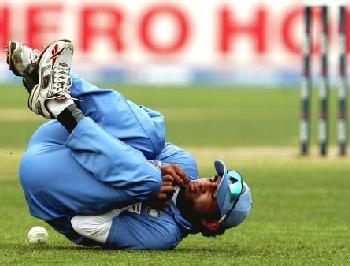How to get more wickets with spin
It's a little known fact that most club cricket games are won and lost with spinners.
The reason is that most club batsmen tend to have a decent defence and not many shots while most club seamers tend to not be good enough to fire out the opposition.
That leaves the spinner to step in. You ready for the challenge?
Who is the most underrated player in your side?
Apart from you (after all, I know how underrated you are) is there anyone in your side who does a great job every week without anyone really noticing?

It could be a timely reminder for the lesser lights of your club, what with many end of year piss ups ceremonies very soon.
Here are a few types the nominations committee may have glossed over. Make sure you don't do the same.
How to get a batting average of 103.54
You can't help but admire Mark Ramprakash. Playing for Surrey, he finished the summer with an average of 103.54 and still had time to go dancing.

The Independent asked him how he did it (the batting, not the dancing) and his answers provoked some thought:
How to win the league

Yesterday, Sussex clinched the County Championship ahead of bigger rivals Lancashire. Considering the side finished dead last in 1997, the team have become a case study in how to win league cricket: Something which all club sides can learn from.
Captain Chris Adams puts it down to teamwork (although Mushtaq Ahmed's 102 wickets may have helped too). While we don't know exactly how they did it, we can look at the clues and come up with some ways club sides can follow the lead of successful teams.
4 more things to do while waiting to bat
One of those sticky problems in cricket is the best thing to do while waiting to bat. After all, surely there must be something you can get on with that is better than sitting down worrying about getting out?
Ian at Cricket Secrets has an article today about that very issue: What to do while waiting to bat. For me the key points are:
Can bad fielders hide?

It's a perennial problem from Test cricket to club level: What do you do with the folks that cant run, throw or catch?
The issue has kept Monty Panesar from the England ODI side and keeps chunky middle-aged blokes in the slips for years. But its a problem that club captains can overcome.
The answer is this: put them in places the cricket ball is unlikely to go. Not much of a secret then. But the real mastery to this trick is to do it subtly, so the opposition doesn't realise what you are up to. So instead of putting your rabbit at mid on automatically, consider these options.
A few notes on field placing
If you are a captain or bowler the chances are that you agonise over setting the right field.
While the wrong field can be a disaster, the right one can make the difference between winning and losing. Especially in lower scoring games. So mastering the basics is essential. As is being able to think on your feet and change your ideas and plots at a moments notice. Perhaps even every ball.
With that in mind, here are some general notes on how to place the field.
4 Tips for all-rounders that work

Kelvin is a club cricket all rounder. Like many other players he is motivated to take his game to the next level.
He sent me an email to ask my advice:
I'm 17 years old and 6'4. I'm considered an all-rounder and have played in the top Malaysian League. However, I still want to improvemy game as I know there are many things I can do better.
Why aren’t you getting more wickets?
If you have ever bowled or captained, you are sure to have asked yourself: Where are we going to get 10 wickets from today?
It's rare in club cricket to have bowlers good enough to knock a side over one their own, so you have to use every trick in the book.
You already know the main ploy: Risk losing in order to win. Now you need to convert that to real life tactics:
How you can control the result of your club game
What are the basic principles behind your tactics on the cricket field?
How do you turn those principles into real life field placings, bowling changes and wins?
Each game may be different, but one thing always remains the same: You must always be trying to win, even at the risk of losing.
But that idea, no matter how sound, is not enough in itself. Here are the practical principles that lie underneath:
Controlling the game: Fielding 2nd

